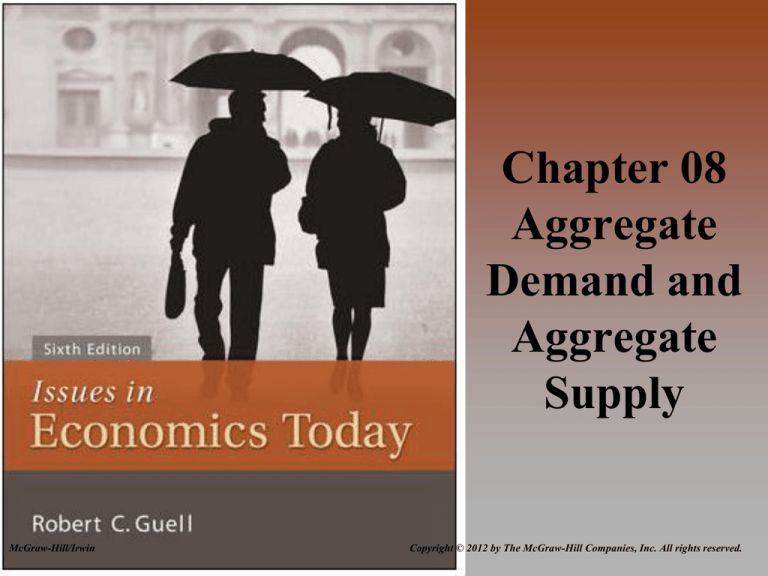
Chapter 08
Aggregate
Demand and
Aggregate
Supply
McGraw-Hill/Irwin
Copyright © 2012 by The McGraw-Hill Companies, Inc. All rights reserved.
Chapter Outline
• Aggregate Demand
• Aggregate Supply
• Shifts in Aggregate Demand and
Aggregate Supply
• Causes of Inflation
• Supply-Side Economics
• How the Government Can Influence
(but probably not control) the
Economy
McGraw-Hill/Irwin
©2012 The McGraw-Hill Companies, All Rights Reserved
8-2
1-2
Aggregate Demand
• Aggregate Demand: the amounts
of real domestic output which
domestic consumers, businesses,
governments, and foreign buyers
collectively will desire to purchase at
each possible price level
McGraw-Hill/Irwin
©2012 The McGraw-Hill Companies, All Rights Reserved
8-3
1-3
Figure 1 Aggregate Demand
PI
AD
RGDP
McGraw-Hill/Irwin
©2012 The McGraw-Hill Companies, All Rights Reserved
8-4
1-4
Why Aggregate Demand is
Downward Sloping
• Real Balances Effect
• Because higher prices reduce real spending power,
prices and output are negatively related.
• Foreign Purchases Effect
• When domestic prices are high, we will export less
to foreign buyers and we will import more from
foreign producers. Therefore higher prices leads to
less domestic output.
• Interest Rate Effect
• higher prices lead to inflation which leads to less
borrowing and a lowering of RGDP
McGraw-Hill/Irwin
©2012 The McGraw-Hill Companies, All Rights Reserved
8-5
1-5
Aggregate Supply
• Aggregate Supply: the level of real
domestic output available at each
possible price level
McGraw-Hill/Irwin
©2012 The McGraw-Hill Companies, All Rights Reserved
8-6
1-6
Figure 2 The Aggregate Supply
Curve AS
PI
Classical
Range
Intermediate
Range
Keynesian Range
RGDP
McGraw-Hill/Irwin
©2012 The McGraw-Hill Companies, All Rights Reserved
8-7
1-7
The Ranges of AS
• Keynesian Range
• Large amounts of unemployment make it so
that increases in aggregate demand have no
affect on wages or prices.
• Classical Range
• Full employment makes it so that increases in
aggregate demand only increase wages or
prices.
• Intermediate Range
• Some sectors of the economy reach full
employment more quickly than others.
McGraw-Hill/Irwin
©2012 The McGraw-Hill Companies, All Rights Reserved
8-8
1-8
Variables that Shift Aggregate
Demand
•
•
•
•
•
Taxes
Interest Rates
Confidence
Strength of the Dollar
Government Spending
McGraw-Hill/Irwin
©2012 The McGraw-Hill Companies, All Rights Reserved
8-9
1-9
Determinants of AD
Variable
GDP
Effect of an
Component increase on AD
C,I,G,X
C,I
Decrease so
AD <=
C,I
Decrease so
AD <=
Effect of a
decrease on
AD
Increase so
AD =>
Increase so
AD =>
C,I
Strength of the X (exportsDollar
imports)
Increase so
AD =>
Decrease so
AD <=
Decrease so
AD <=
Increase so
AD =>
Government
Spending
Increase so
AD =>
Decrease so
AD <=
Taxes
Interest Rates
Confidence
G
McGraw-Hill/Irwin
©2012 The McGraw-Hill Companies, All Rights Reserved
8-10
1-10
Figure 3 AD Increases
PI
AS
PI’
PI*
AD’
AD
RGDP*
McGraw-Hill/Irwin
RGDP’
RGDP
©2012 The McGraw-Hill Companies, All Rights Reserved
8-11
1-11
Figure 4 AD Decreases
PI
AS
PI*
PI’
AD
AD’
RGDP’
McGraw-Hill/Irwin
RGDP*
RGDP
©2012 The McGraw-Hill Companies, All Rights Reserved
8-12
1-12
Variables that Shift AS
• Input Prices
• Productivity
• Government Regulation
McGraw-Hill/Irwin
©2012 The McGraw-Hill Companies, All Rights Reserved
8-13
1-13
Determinants of AS
Variable
Effect of an
Increase on AS
Effect of an
Decrease on AS
Input Prices
Decrease so
AS
Increase so
AS
Decrease so
AS
Increase so
AS
Decrease so
AS
Increase so
AS
Productivity
Government
Regulation
McGraw-Hill/Irwin
©2012 The McGraw-Hill Companies, All Rights Reserved
8-14
1-14
Figure 5 Increase in AS
PI
AS
AS’
PI*
PI’
AD
RGDP*
McGraw-Hill/Irwin
RGDP’
RGDP
©2012 The McGraw-Hill Companies, All Rights Reserved
8-15
1-15
Figure 6 Decrease in AS
PI
AS’
AS
PI’
PI*
AD
RGDP’
McGraw-Hill/Irwin
RGDP*
RGDP
©2012 The McGraw-Hill Companies, All Rights Reserved
8-16
1-16
Causes of Inflation
• Demand Pull Inflation: inflation
caused by an increase in aggregate
demand
• Cost Push Inflation: inflation caused
by a decrease in aggregate supply
McGraw-Hill/Irwin
©2012 The McGraw-Hill Companies, All Rights Reserved
8-17
1-17
Government Influence:
Aggregate Demand
• Government can influence economic
activity with aggregate demand side
policies affecting:
• Taxes
• Government Spending
• Interest Rates
McGraw-Hill/Irwin
©2012 The McGraw-Hill Companies, All Rights Reserved
8-18
1-18
Government Influence:
Aggregate Supply
• Government can influence economic activity
with aggregate supply side policies affecting
• input costs (labor and wage)
• reducing regulation
• Increase incentives to
• Work
• Take Risks
• The actions are call Supply Side Economics
McGraw-Hill/Irwin
©2012 The McGraw-Hill Companies, All Rights Reserved
8-19
1-19





